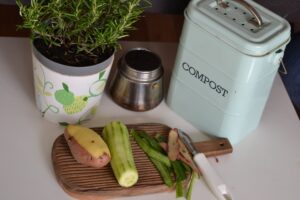
Zero-Waste Holiday – Part 1, The Tree and the Decorations
The holidays are upon us! Which means decorations, food, fun, and gifts galore! But unfortunately, this also means a massive increase in the amount of waste that is generated during this time of the year. So I wanted to share some ways in which you can have a zero-waste holiday season!
You may have seen the stories and columns back in October about the wastefulness of Halloween, in particular with candy wrappers and costumes, and certain decorations – like the faux spider web, which is HORRIBLE for the environment. (I just dug some up in my backyard from a Halloween party at least a decade and a half ago).
Unfortunately, the holiday season, and particularly Christmas, is no different. It has perhaps the biggest negative impact on the environment of just about any holiday, with Halloween, Easter, and the 4th of July close behind it.
This is because it is the holiday people go ALL out for. The decorations. The food. The presents. The tree. Traveling. All of it has an impact that lasts long past the end of the holidays. This is in both terms of the actual waste that it produces, and the emissions that are used with both electricity and gas.
But don’t get overwhelmed or worry that your holiday cheer needs to end – there are many different ways to cut back on wastefulness while still enjoying the holidays!
So we’re going to look at a few major areas in which we can all work to be mindful, minimalist, and zero-waste during this time of year. Since there is so much to cover, this has been split up into 3 different parts so I don’t overwhelm you with information all at once!
Because trees are usually the first thing that goes up for the holidays followed by decorations, we’ll start with those, followed by the festivities and food that come next, and end it on what usually wraps up (or unwraps) the season – the gifts and how they’re presented.
Now you may be asking, what is ‘zero-waste’?
Zero-waste is defined as, “… a goal that is ethical, economical, efficient and visionary, to guide people in changing their lifestyles and practices to emulate sustainable natural cycles, where all discarded materials are designed to become resources for others to use”, [1].
I don’t expect anyone to do everything I suggest in this or any article, but even if you can try at least one or two things, it makes a huge impact.
We’re going to cover a lot, so buckle up and get ready to have the most environmentally friendly holiday you’ve ever had!
Trees
Setting up and decorating a Christmas tree is generally the first thing people do in honor of the holiday, if they don’t start with decorating the outside of the house that is. But whatever sequence you start the holidays with, when you do get to the tree keep in mind the following:
According to the authors of an article on the Weather Channel website titled, ‘Real vs. Fake Christmas Trees: Which is Better for the Environment?’, they wrote that when it comes to getting your tree, “what matters is how far you drive to get your evergreen, how you dispose of it and how long you use the artificial tree”, [2].
With that being said, it’s up to you to decide which option will be best for you and your family, especially in the long run.
Plastic/Artificial Tree
If you choose to go with an artificial tree, you will have to consider how long you are willing to hold on to it, if you have the storage space to keep it, and what you are willing to do with the tree if you no longer wish to keep it.
If you are willing to keep an artificial tree to use year after year for at least 7-10 years, then this is a decent choice.
And, if you are willing to make sure that the tree will be donated to someone or someplace that will continue its usage and lifespan, then an artificial tree is a good option.
However, if you plan to get an artificial tree and do not intend to keep it for several years, and do not intend to pass it on to another person, then consider getting a live tree.
Now with a live tree, you have a couple of different options.
Live Cut Tree
The first of which is to get a live cut tree from some tree nursery, home improvement store, tree lot, tree farm, or other location. To make the best impact on the environment, you should try to find the closest location to minimize the emissions used to go pick the tree and transport it home.
Also, bear in mind that it is water-intensive to grow live trees that are cut to sell for Christmas. But, the trees produce oxygen while they’re growing, so there is somewhat of a balance between the good and the bad here environmentally speaking. And if you recycle the trees, it will contribute to producing soil and mulch for gardens and farms.
That being said, should you choose to get a cut tree instead of an artificial or living tree, please do your best to make sure you are recycling your tree. Depending on your area, there are often times different programs and locations where tree collection spots will be set up where you can drop off your tree after the holidays.
Through these programs, the trees will be composted and turned into mulch, which will produce nutritious soil to be used at local farms and gardens.
Please remember though – flocked trees (the ones with artificial snow sprayed on) are NOT recyclable, and you must remove all ornaments, hooks, tinsel, and any items that are not organic prior to dropping off your tree!
Living/Potted Trees
The next option is one that is a little more dedicated, and that is to get a live, potted tree. For this option, you should consider a couple of things, such as how much space you have to work with, how you intend to manage the tree you pick, the type of tree you would like, how fast it grows, and how big it gets. And, you will want to consider where you will keep the tree and how easily it can be moved if needed.
For instance, if you have a living tree in a pot, you can either decide to keep it inside year-round as a houseplant (as long as you’re giving it ample space and access to good sunlight for several hours a day), or you can move it outside the majority of the year, and bring it back inside for the holidays. This decision will come down to how easily you can move the plant, which also will be dependent on how fast and how tall it will grow year after year.
There are, of course, many options for small-size tabletop trees that are great for studios, apartments, and dorm rooms! And, they make for good house plants by looking nice, smelling good, and purifying your air!
Whatever tree or another plant you decide on, make sure that if you have pets, that they are not tempted to eat the tree or plant, as many holiday plants and houseplants can make fur-babies sick. Some pine trees are mildly toxic to cats and dogs if they consume the needles, so if you choose a live, cut tree, you’ll have to keep an eye on your animals with that option as well.
With that being said, regardless of if you have pets or not, if you plan to keep a pine tree inside year-round, even just for the first couple of years of its life, you’ll have to keep up on all of the needles that will fall off over time, naturally and otherwise. If you’re willing to manage a bit of a mess throughout the year, and your tree isn’t taking up too much space, this option would work well for some people.
Depending on the type of pine tree you choose, bear in mind that, according to a site called Garden Nerdy, “On an average, the yearly growth rate of pine trees is less than a foot to more than two feet”,[3]. So, you will have to decide which tree you want and what level of growth you’re willing and able to work with over the long term.
By that, I mean you will have to decide if you want to get a small, baby tree for your first year, and let it get bigger and bigger every Christmas. At some point, you may have to keep the tree outside throughout the year until the holidays come back around, but if you have a decent-sized pot that isn’t too heavy and you can get a sturdy rolling cart, it is possible to move, up to a certain age of the tree.
You’ll also want to remember to check the tree whenever you’re moving it back inside for any critters and things that may have taken up residence in and around the tree. Of course, this is just as much a possibility with a tree you get at the tree farm – such as praying mantis eggs, [4].
At some point, depending on the tree you chose, it may become too big to bring inside, if you keep it out of the house most of the year. But, if you got the tree at a young age, you won’t have to worry too much about this. You can also retire your older tree when it’s gotten too big by permanently planting it in your own garden, donating it to somewhere, like a school, park, or other places, planting it in an approved location in a strategic area (like a place in your local public lands), or, after its last Christmas spent in the house, you can bring it to a tree recycling or composting location, if you have no other options.
If you choose this option, and you’re giving the tree ample lighting, water, space, and nutrients, you can don’t have to worry every year about setting up or buying a tree. And, your house will smell nice, and your air will be fresher.
Or, if you don’t care to follow tradition too much, there are of course, other options for trees you can substitute, that actually qualifies as houseplants that you can still decorate. Certain palm trees and even dwarf fruit trees might fit this description. In that case, you won’t have to worry too much about pine needles.
Worst case scenario, as I mentioned at the beginning of this section, you can always look at live tabletop Christmas trees that are very tiny!
My last ‘argument’, if you will, for this choice for your Christmas tree needs to consider, is that if you have kids and you choose the dedicated route of getting a live tree, they will get to grow up with the tree and it will make the experience even more special for them and your family!
And, it is a great starting place for kids to understand how things grow, and they can learn responsibility at a young age through making it a chore to remember watering it!
Who knows? Your kids might even grow up to become master gardeners because of that tree, or inspire them to become an arborist or botanist!
Other Options
If you don’t want to get an artificial tree, live cut tree, or a living tree for Christmas, or don’t have room for a real or fake tree, there are some other options that have less of a negative impact on the environment, and can provide more opportunity to have fun as a family!
This can work especially for people and families who live in small spaces or have limited room for a tree, even just for the month of December.
Some craft stores have felt or fabric trees that are flat and can be hung up on the wall, with little ornaments (often with velcro) that can be used to “decorate” the tree!
If you are an artist, or your kids are, why don’t you task yourself and the kids with making a tree! You can go relatively simple, and have the kids draw out their own tree on a big piece of paper and have them draw on decorations.
You can also make a real project out of it together, and see about making some kind of 3-dimensional tree! I will let your imaginations see to that idea.
Think outside the box and have fun!
Whatever option you decide for your Christmas tree, go with what works best for you, your family, your budget, and all other contributing factors, while also being mindful of the environment to the best of your ability and given situation!
Continue to the next page to check out the next section – Decorations and Ornaments!



